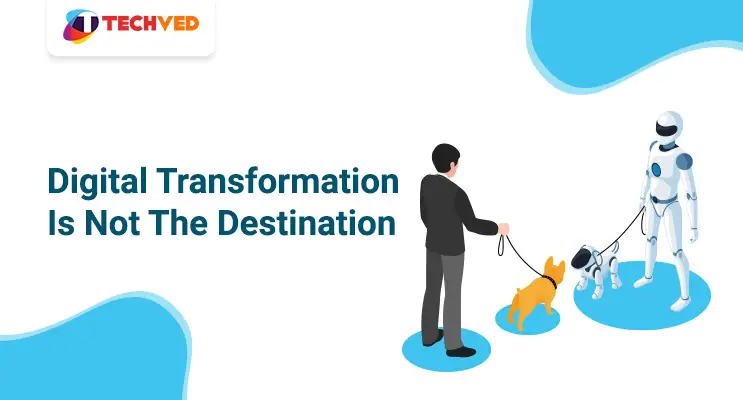Did you ever imagine that a camera, an audio player, an email server, and a phone call could all be merged into one unit?
A few years ago, people couldn't even consider the likelihood of this happening. Nobody thought we could use a computer that could fit in the pockets with all the facilities! But now its a fact for all of us.
Also, have you ever wondered how the dynamics changed? Now we can buy multiple things from one single website. People do not need to visit different websites for different requirements. Brands like Amazon and Flipkart have everything ranging from clothes to groceries and health products to beauty products available all in one single platform. This is where digital advancements have reached and that’s how digital transformation programs begins. These are a few examples of digital transformation projects, today it has reached another level since everyone moved their business to digital platforms.
Everything we want is available at our fingertips. In fact, this entire Digital Transformation has also done well for nature as a lot of sectors have now gone paperless. Banks, insurance, healthcare, etc. have undertaken Digital Transformation initiatives and have reduced if not completely stopped the use of paper. So Digital Transformation in many fields has not only eased the life of many individuals but also contributed towards helping mother nature.
Another argument to be illustrated is that it is not only the company that is experiencing a digital transformation, but we, as consumers, are also part of this ever-evolving phase. We are end-users, and some kind of transformation in the digital world impacts our lives in one way or another.
Digital Transformation needs to be undertaken with an organizational approach Businesses that have adopted this are reaping the benefits and enjoying the advantages. However, there are still businesses that have not completely undergone a Digital Transformation. These businesses have started to realize the importance and benefits Digital Transformation brings to the table and are considering to fully adopt it in their business model.
While doing so, there are a couple of things businesses need to keep in mind to ensure that they are on the right path and what they are doing is right. A lot of businesses fail not because they don’t undergo Digital Transformation, but because, their approach towards this is still amateur. As complex as it sounds, digitally transforming businesses is not as hectic and time-consuming as most perceive it to be. If the right steps are followed and the right set of strategies and guidelines are followed transforming businesses digitally is indeed the best solution to always stay ahead in the market.
In this article, we learn about 5 golden rules that you must abide by if you want to experience a digital transformation for your company.
Every business has different requirements and agendas. So, the plan of action for digital transformation business in different sectors and fields should be different too. However, when a business considers to digitally transform themself, they have to take into consideration their target audience also.
Now let’s have a look at a few key points to keep in mind to ensure you have a successful Digital Transformation journey.
5 Golden Rules
1. Get a clear vision

It is important to know how to get a clear vision. No plan or project can be successful if a clear vision is not laid down right at the beginning. Leaders should convey the organizational goal and vision clearly to their teams. There should be complete transparency if businesses wish to smoothly execute their plan. This ensures that everybody is on the same page and everybody working on the project knows where they are heading towards. The foundation of the Digital Transformation journey can only be strengthened if the vision is clearly communicated to everybody who is working on it.
2. Focus on the customers

In this competitive world, it is very important for businesses to have user-centric solutions if they want to make it big. Understanding user needs and requirements help you understand what your target audience actually wants. Once you know what they want, you can cater to them accordingly. Good User Research is recommended not only at the start but also during the digital transformation process. This helps get an in-depth understanding of what the target audience expects from a particular brand. A user-centric approach where the customer focus is more on the target audience is always considered to be a wise decision for any organization.
3. Digital Transformation is not the destination

For those who think Digital Transformation implementation is a one-time solution to make their business grow, need to know that this is an ever-evolving process and not the end goal. This is a journey business undertake to stay ahead of their competitors. There is always something new trending in the market so it is important to stay up-to-date at all times.
4. Build a flexible strategy Teamwork is important

It is important for businesses to be flexible with their plan of action. Staying stringent and adamant on one single path is not a good idea. I am sure we have all experienced this in our professional life, not all plans and strategies work as per schedule. There is always scope for delays, iterations, and amendments. It is no different when it comes to digitally transform your business.
Digitally transforming business cannot be done by one single individual. It requires different departments and teams to come together to create great solutions. All teams working on the project should be well aligned with each other. They should be in sync with each other to maintain consistency and uniformity throughout the process of digital transformation strategy framework. Protocols should be followed and teams should regularly communicate with each other to achieve the best results.
5. Accept failure

Staying positive and accepting failure is the first step to success. There could be delays, stages of failure analysis and a number of iterations but one must take this in a positive spirit and work harder to avoid repetition of mistakes. One should not get demotivated because of failure of technology or failure of project, but instead, learn from their mistakes and make sure that they don’t repeat it. Falling down is a part of the journey but picking yourself up and moving forward is what it takes to be successful in your endeavor.
Conclusion
When a company plans to undergo a digital transition, a lot of things are at stake. It should always consist good research topics on digital transformation. These five golden principles must be followed in order to reduce the probability of losses and maximize the rewards and profits. These laws must be complied with in order to ensure that companies are on the correct road to success on their Digital Transformation journey.
1. What is digital strategy example?
The goal of digital strategy is to leverage technology to improve business performance, whether that means developing new products or redesigning existing ones. It outlines an organization's strategy for gaining new competitive advantages through technology, as well as the strategies it will employ to make these improvements. Suppose if you want to incorporate digital transformation in your business, that means you should be available on all the digital platforms. The process of building your foundation to planning, developing, & successfully deploying comes in digital strategy.
2. Why is digital transformation strategy important?
Digital transformation enables an organization to stay up with changing client needs and, as a result, to thrive in the future. It enables businesses to compete more effectively in an economic environment that is continuously changing in reaction to technological advancements.
- It saves time in processes, which decreases expenses.
- It facilitates mobility and remote communication, hence decentralizing manufacturing.
- It boosts operational effectiveness and productivity.
- It provides the company with a competitive advantage by allowing it to improve the quality of its products.
3. Why is the world moving to digitization?
Some organizations had already began the digitizing journey prior to the pandemic, giving them an advantage. Since everything turned digital, many people have begun post covid. COVID-19 can be viewed as a forerunner, showing where firms should concentrate their efforts in order to prosper in the future with considerably more
flexible and robust business processes. Digitization accelerates development, promotes economic progress, brings people closer together, and allows for greater resource utilization.
4. How do you rescue a failed project?
Many projects fail due to a lack of a defined vision or strategy, as well as teams who are not aligned or working toward the same shared goal. There is no clear grasp of what the project is aiming to achieve in the first place, therefore a scattergun approach between teams frequently ensues. The difficulty here is at a greater level. If there is no executive buy-in, digital transformation projects are mislabeled and therefore not successful.
5. How would you describe your customer focus?
It's all about putting the customer first, with their needs and desires at the forefront. Customer focus is a strategy that prioritizes your customers' needs. We believe in providing our consumers with exactly what they desire. Being a customer-focused company we create solutions that are devoted to increasing customer satisfaction and developing strong customer relationships.